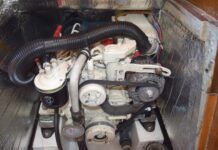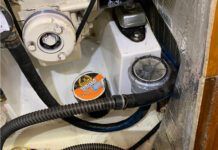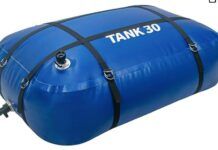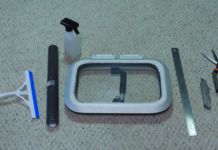288 The best way to get all of the oil out of the engine (after a thorough warm-up) is to drain it from the plug at the bottom of the pan. In boats, however, its often tough or impossible to get at that plug. The optimum solution is to have an oil-change system permanently installed, with a hose from the oil sump to a bulkhead-mounted pump. That, too, is impractical on many boats. So we often have to go in through the dipstick hole. There are different pumping methods available here, too. In the May 15, 2004 issue, we published the results of a test of portable oil-change pumps, and found two Jabscos the Porta Quick and Jabsco 17850 to be the best electric pumps. However, those pumps were mounted on top of a 3.5-gallon bucket, a design that was top heavy and difficult to stow. The West Marine Oil Vac was chosen as the best manual pump in the 2004 test, mostly by virtue of its price. The next year, we used the West Oil Vac and found that it wouldnt hold its prime without furious pumping, so we carried on for two more years with a small Beckson pump rigged with a long dipstick probe. It works, and its cheap, but it takes a good 20 to 30 minutes of tedious pumping, often holding the pump between the knees while juggling half-filled gallon jugs. There are pumps that can be run in line with a power drill, but these have their own set of challenges. If you have electricity and an extension cord, its no big deal and less messy than manual pumping (as long as you keep all the elements of the system together). But most battery-powered hand drills don’t like to be run for the amount of time it takes to evacuate several quarts of oil from an engine. So without a good-sized inverter, the inline drill pump isn’t the best way to go without AC power at hand. This past fall, we couldnt help pausing wistfully in front of the display of the Jabsco Oil Changer System that the local West Marine management had cleverly placed out front to seduce manual-pump refugees. Jabsco, in this case, decided to mount a small, self-priming, oil-resistant diaphragm pump directly on a sturdy, 3.5-gallon polypropylene tank that can be stood up or laid flat, has a carrying handle, and pours its contents easily. They provided 7-foot wires with clamps for a 12-volt battery, an 8-foot clear plastic hose for insertion into the dipstick hole, a protected switch on the bottom of the pump and 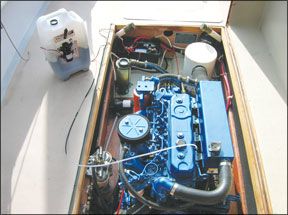
We bought one and tried it out when it was time to change the oil for winterization in one of our test boats. (Always change the oil before putting the boat up for winter storage. This keeps the acids and grunge in the old oil from festering on metal surfaces in the cold engine.)
The engine is an Isuzu 96-hp diesel that holds seven quarts in the pan/crankcase and about a quart in the filter. The Jabsco system handled most of the seven quarts in about eight minutes, and we took another couple of minutes shifting the dipstick tube up, down, and around to get what we could from the very bottom of the pan. (Its often hard to tell if the end of the tube is at the lowest, best place in the pan. Stick it in too far, and the tip can curl right back up out of the reservoir. So you do have to move the tube around a good bit, keeping a rag around it to prevent spills.
The job was neat and orderly, and we saved a lot of time compared to our old system. The best thing was that we could get away from the engine and do some other chores while the Jabsco chugged away.
The pump draws about 4 amps, which is negligible in a chore that takes so little time.
Theres a three-year warranty on this product (model 17860-0012 for 12-volt systems; model 17860-0024 for 24-volt systems). Its currently available from westmarine.com for $110, and Boaters World for $130. This seems expensive at first glance, but the whole is more valuable than the sum of its simple parts, and the system does reduce oil-change dread substantially. As we all know, the health and longevity of an engine is closely related to how often we give it clean, new oil, and new filters.
Contact
JabsCo, 978/281-0440,
jabsco.com













